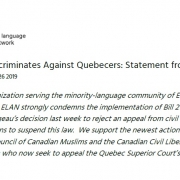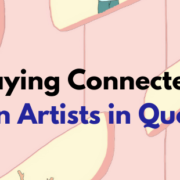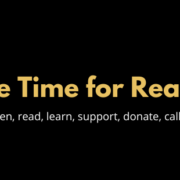Disability, arts practice, and COVID-19 in Quebec
Initiative by ELAN’s Inclusion Committee
Written by Renée Yoxon
As the COVID-19 pandemic continues to unfold, artists everywhere have had their livelihoods impacted. In Canada, no province has been harder hit than Quebec. Quebec’s Premiere, François Legault, and Minister of Culture and Communications, Nathalie Roy, recently announced a recovery plan for Quebec’s arts sector that included hundreds of millions of dollars in investment. But is this recovery plan reaching Quebec’s artists with disabilities? Disabled artists[i] are far from monolithic. They occupy every race, class, gender and sexuality, and use every artistic medium to express themselves. Because the experiences of artists with disabilities are so broad and diverse, the needs of individual disabled artists have lacked the necessary critical mass to get the coverage they deserve.
Within disability activism, many organizations have already begun to see the need to compile more qualitative data to truly understand the lived, intersectional experiences of people with disabilities. In the spirit of adding to this conversation, I spoke with three Quebec-based artists – Bára Hladik, Corinna Hodgson, and Willow Cioppa – about how COVID-19 has impacted their lives, disabilities, livelihoods, arts practice(s), and sense of artistic community.

Bára Hladík
Bára Hladík is an emerging writer, multimedia artist, workshop facilitator and human rights reporter currently based in Tio’tiá:ke (Montréal). Born to Czechoslovak political migrants in Ktunaxa Territory, “Canada”, her work untangles the effects of disability, queerness and diaspora from the embodied subconscious through illustrations, poetry, sound and dreams.[ii] Her latest micro-offering is a series of illustrated “Spells Against Ableism.” Bára has ankylosing spondylitis, an autoimmune disorder that causes vertebrae in the spine to fuse. This disorder is treated with immunosuppressants. Throughout the pandemic, Bára has had to weigh the risks of allowing her inflammatory disease to thrive or being immunocompromised while a deadly and contagious virus spreads through her community.
Bára and I spoke at length about the different paces at which disabled artists do things compared to their non-disabled counterparts. She told me that even before the pandemic, she was frustrated that even within Disability Arts[iii], “often the people who are given most visibility are the ones who are able to produce in a particular way and there’s a lot less focus on artists who are being just being creative”. There are so many artists with disabilities who have to go at a pace that doesn’t necessarily line up with societal expectations of what an arts career trajectory should look like. Many disabled artists are not able to go to university and get an arts degree because of physical or financial barriers to access. Bára would like to see more young disabled artists “who are learning, and in the process, and don’t quite have their thesis statement yet.”
For artists like Bára, it can take years to silence the voice that holds their process to the same standards and timelines as their non-disabled peers. During the last several months of quarantine, Bára has had to, once again, grapple with these voices as non-disabled people have taken to online spaces in higher numbers than ever before, posting about “finding themselves” or using quarantine as an artistic residency. “Meanwhile,” Bára says, “we are fighting for our lives, cut off from regular care, and likely have to reframe our practice with little or no support.”
As an immunocompromised person, Bára is among Quebec’s most vulnerable population affected by COVID-19. And while the pandemic has made more people than ever aware of what “immunocompromised” means, Bára has not found that this has improved her access to artistic community. “I feel very alienated, to be honest,” she says, “because I see people not giving a fuck. And in some ways, certain folks have definitely reached out and are conscious and caring and I feel community with them … [but] on the other hand, I see people not taking it seriously and continuing to put themselves first.” As more arts spaces in Quebec begin to open up, those that don’t enforce the use of masks and social distancing will not be accessible to Bára.
“Being at high risk and economically marginalized as disabled artists, COVID-19 exacerbates all the problems we’ve already been facing, putting pressure on our artistic practices as we may not be able to pursue them during this time, or alternatively we have to rely on them for survival.”
-Bára Hladík
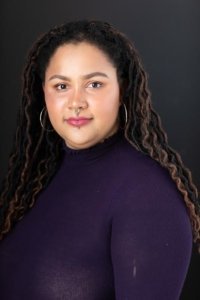
Willow Cioppa
Willow Cioppa is an interdisciplinary artist, playwright, and actor whose work focuses on the nuances of sexuality, trauma, self-reflection, femininity, Blackness, and their undying love for rap music. Born and raised in Ottawa and now living in Montreal, their work has taken on many faces since childhood; from diaries to painting, to illustration, to moody poetry written in dark spaces, and now to theatre where their aim is to create decadent visual, auditory, and written landscapes.[iv] Recently, Willow’s play Dark Red was presented by Black Theatre Workshop and Playwrights’ Workshop Montreal.
Willow, who has bipolar disorder and experiences chronic pain, expressed how lucky they feel to have had their access needs largely met in their arts sector, pre-coronavirus: “I have been truly blessed with mentors and collaborators who advocate for my needs in my artistic fields. My community, particularly in theatre, has uplifted me in ways that I will never be able to fully articulate.” However, under COVID-19, Willow’s output has slowed drastically as they feel the weight of everything that is happening right now.
“I’m just trying to write when I can and not get angry with myself when the pain is too much, or when I’m too tired, or when I just want to sit on my balcony in the sun and ignore my responsibilities. Especially with the increased urgency of the Black Lives Matter movement, I find myself, as a Black artist, struggling to write when I barely have the words to articulate my day-to-day emotions.”
Willow’s experience is a perfect example of how an artist who is both Black and lives with a disability will have the pace of their work changed in ways that white disabled artists won’t experience.
“I think there is so much power in being able to voice our experiences, and to be heard. I truly believe that I have consistently had my access needs met because I have been able to articulate what I need to people I trust. It is in the silence that we suffer. I believe we’re getting to a point where we can amplify the experiences of the vulnerable and marginalized in our community with honesty and respect and I think that this is where true equity begins: in being able to have our needs heard and met without fear of judgment.”
-Willow Cioppa
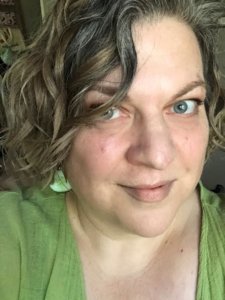
Corinna Hodgson
Corrina Hodgson is a Queer, disabled playwright and dramaturge currently residing in Tiohtià:ke. She is a part of the Montréal English Language theatre community wherein she finds sustenance and strength. She is the co-founder and co-producer of The Rose Festival MTL, a multidisciplinary queer arts festival, in partnership with Playwrights Workshop Montreal and Montreal Arts Interculturels. Since her teen years, Corrina has been living with arachnoiditis, which is a pain disorder caused by the inflammation of one of the membranes that protects the nerves of the spinal cord. It causes severe stinging, burning pain, and neurological problems. She had her first spinal fusion to help mitigate this pain at an early age but continued to experience pain in the years following. As a result, her left foot is, in her words, “for decorative purposes only”.
As a mid-career disabled artist, COVID-19 is but a blip on the timeline of hurdles and challenges that Corrina had to face. In our conversation, we spoke at length about career trajectories and timelines for disabled artists and how they so often they don’t line up with those of their non-disabled peers. In Corrina’s case, she was forced to leave her artistic community for a decade in order to work in a job with extended healthcare benefits in order to adequately treat her arachnoiditis. It wasn’t until she married and was put on her wife’s benefits that she was able to restart her career, ten years behind her peers.
When I asked Corrina if she had difficulty getting her access needs met in Montreal’s theatre community, she said: “Playwrights Montreal has gone out of its way to make sure that I have rehearsal space that was financially accessible to me, and that was in the very early days when I was first back writing. And that just bolstered me so much because most organizations that are run by able-bodied people think of accessibility as solely being physical accessibility and they don’t understand that for those of us who are disabled, our income is largely affected too. When you’re making things accessible, financial accessibility is an important consideration as well.”
Financial accessibility for disabled artists is one of the big reasons why artists lag behind their non-disabled peers. Disabled lives are more expensive than non-disabled ones. They have more healthcare costs, more travel costs, more parking costs, more dietary costs, more accessibility costs. In disability activism this is known as the “crip tax.” In Corinna’s case, the extra costs associated with her disability prevented her from working in the arts for a decade due to a lack of extended healthcare benefits. And although Corrina and I did talk about how COVID-19 has restricted the scope of her writing work to just sitting at her computer, the impact of that paled in comparison to the impact of the ten-year gap in her practice.
“I’ve felt apologetic and shame around this ten-year gap in my resume. I feel like I somehow failed in my art or never came through on what I promised. That somehow, if I had been… What? Stronger? Better? Had more fortitude? I would have somehow magically been able to continue creating through all the pain and with no money? I know intellectually that it’s impossible to do but when you’re first stepping back into the fray after so much time away… There’s this attitude that you’re only as good as your last creation and what do you do if your last creation was in like 2008? I wish I hadn’t wasted so much time thinking about that.”
-Corrina Hodgson
Disabled artists contain multitudes. There is no one-size-fits-all answer to what artists with disabilities need in order to fully participate, especially during a global pandemic that affects everyone differently. And in the future, when the urgency of the pandemic begins to ebb, the urgency of systemic ableism and barriers to access will still be present for disabled artists. When I asked Bára, Willow, and Corrina what arts organizations could do to further equity in the arts sector, they all said a variation on this: Arts organizations need to be listening way more. They need to be making space for artists with disabilities to voice their needs and then going out of their way to meet those needs.
Furthermore, arts organizations need to find ways to provide funding so that disabled artists can have an arts practice at all. An arts practice can be a lifeline for anyone, but especially those experiencing marginalization. We need to find creative solutions to the barriers present in the paths of current and future artists with disabilities, but we can only begin to remedy those barriers once we understand and acknowledge them. We need to continue to hear stories and experiences from disabled creators so that the picture of their real lives can come into focus.
———-
Renée Yoxon is a queer, non-binary, and disabled singer, songwriter, pianist and teacher. They passionately believe that singing is a birthright and that voice lessons teach us about ourselves. They work hard to provide gender-affirming voice lessons to transgender individuals. In addition to their fulfilling Arts Practice and teaching careers, Renée works as a disability activist through freelance writing and as part of the communications team at DAWN Canada.
[i] Note about language: Corrina, Bára, and myself prefer identity-first language (“disabled person”) whereas Willow prefers person-first language (“person with a disability”) so throughout this article I alternate using both phrasings in an attempt to accommodate everyone.
[ii] Bio provided by Bára Hladik.
[iii] The label “Disability Arts” have evolved a lot over the last 40 years. Here it is meant to refer to the subsector of the arts community occupied by any disabled artist / artist with disabilities who chooses be included in this subsector.





